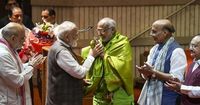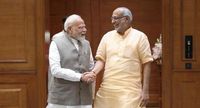In a closely watched contest that underscored shifting political tides in India, Chandrapuram Ponnusamy Radhakrishnan, the National Democratic Alliance’s (NDA) candidate, was elected as the 15th Vice-President of India on September 9, 2025, defeating opposition nominee B Sudershan Reddy by a margin of 152 votes. The election, which saw 767 out of 781 eligible Members of Parliament (MPs) casting ballots, was marked by cross-voting, political maneuvering, and a surprising abstention by a key regional player, all casting fresh light on the country’s evolving parliamentary dynamics.
Polling began promptly at 10 a.m. at Parliament House, with Prime Minister Narendra Modi himself casting the first vote, according to IBNS. By the end of the day, Radhakrishnan had secured 452 votes to Reddy’s 300, while 15 ballots were declared invalid. The required majority of first-preference votes, lowered by the number of invalid ballots, stood at 377. This outcome, though widely anticipated given the NDA’s numerical edge, left both camps with plenty to ponder.
Radhakrishnan’s victory margin, while decisive, was notably slimmer than in the previous vice-presidential election. In 2022, Jagdeep Dhankhar bested the opposition’s Margaret Alva by a far larger gap—528 votes to 182. The closer result this time, as reported by IBNS and The Times of India, reflected a changed political landscape following the 2024 Lok Sabha elections, which saw the opposition INDIA bloc emerge as the strongest since the current regime took power in 2014. The NDA, with support from the YSR Congress Party, was expected to muster 438 votes at best, but Radhakrishnan’s tally exceeded this by 14, raising immediate questions about cross-voting and party discipline.
Before the election, Radhakrishnan had a promised base of 439 votes, including 11 from the YSR Congress, while Reddy was expected to draw 324, according to The Indian Express. The preference of four MPs remained unclear. The actual results suggest that at least 15 opposition MPs may have cast their ballots for the NDA nominee, a claim quickly seized upon by BJP leaders. Union minister Kiren Rijiju asserted, “Many opposition parties have also voted for our NDA candidate. This is also a very good sign.” BJP leader Amit Malviya was more pointed, responding to Congress’s earlier boasts of unity: “All 315 voted… but for whom is the real question! Despite all the noise and bravado, the INDI Alliance candidate managed only 300 votes, 15 short of what they had confidently claimed.”
Congress general secretary Jairam Ramesh, however, sought to frame the outcome as a step forward for the opposition. He noted, “Opposition performance has undeniably been most respectable. Its joint candidate Justice (retd) B Sudershan Reddy secured 40% of the vote. In 2022, the Opposition had received 26% of the vote in the vice presidential elections.” Congress MP Imran Masood echoed this, highlighting a 14% increase in votes for the opposition compared to the last contest. Still, the unexplained deficit of 15 votes and the presence of 15 invalid ballots left opposition unity under a cloud. The voting behavior of the Aam Aadmi Party, which had pledged support to Reddy, also remained unclear.
The contest was not just about numbers. It was, in the words of Congress president Mallikarjun Kharge, “more than an election; it was a battle of ideology, reaffirming that governments with authoritarian tendencies must be checked to protect our Constitution and Democracy.” Kharge congratulated Radhakrishnan and commended Reddy for his “spirited and principled fight.” For the NDA, the win was seen as a validation of its parliamentary strength, but the cross-voting and opposition gains served as reminders that the political terrain is far from settled.
Radhakrishnan’s ascension holds special significance. As noted by Devdiscourse, he is the third leader from Tamil Nadu to become Vice-President and the first Other Backward Classes (OBC) leader from South India in this high office. With roots in the RSS and BJP, he brings a reputation for soft-spoken, non-confrontational leadership. His résumé includes stints as Governor of Maharashtra and as a two-term Lok Sabha member. Prime Minister Modi, in a congratulatory message on X (formerly Twitter), praised Radhakrishnan’s commitment to “serving society and empowering the poor and marginalised,” adding, “I am confident that he will be an outstanding VP, who will strengthen our Constitutional values and enhance Parliamentary discourse.”
As Vice-President, Radhakrishnan will serve as the ex-officio chairman of the Rajya Sabha, where his legislative and constitutional experience is expected to play a key role. His selection is widely viewed as an effort to bridge political narratives, especially given his background and the symbolism of his election in the current climate.
Amid the excitement, the Biju Janata Dal’s (BJD) decision to abstain from voting drew attention and speculation. Known for its sharp criticisms of the BJP, especially over issues like women’s safety and the Polavaram dam project, the BJD’s abstention was seen by The Hindu as a strategic move to maintain “equal distance” from both the NDA and INDIA blocs. Sasmit Patra, BJD’s Rajya Sabha leader, stressed that the party’s priority was the welfare of Odisha’s 4.5 crore people and that the decision was reached collectively. The abstention, however, undeniably bolstered Radhakrishnan’s prospects, and analysts see it as part of a long-standing, if unofficial, pattern of BJD softening its stance towards the BJP on crucial votes.
Over the years, the BJD has supported the BJP on key legislation, including the Jammu and Kashmir Reorganisation Bill, the Citizenship Amendment Act, and even demonetisation. Political analyst Rabi Das explained to The Hindu that the relationship between the two parties, despite formal separation, has often been one of mutual convenience—each wary of giving the Congress any space for revival in Odisha. There are also suggestions that the BJD’s leadership is cautious about antagonizing the central government, given concerns over potential investigations into its long tenure in power.
The Vice-President election was necessitated by the sudden resignation of Jagdeep Dhankhar on July 21, 2025, who cited health reasons. While some in Delhi’s political circles suspect deeper motives, the official explanation remains unchanged.
For now, Radhakrishnan’s victory is both a testament to the NDA’s organizing prowess and a signal of the opposition’s growing, if still fragmented, strength. The cross-voting, shifting alliances, and the BJD’s calculated abstention all point to a political landscape in flux—one where old certainties are giving way to new realities. As Radhakrishnan prepares to assume his new role, the coming months promise further intrigue in India’s ever-evolving parliamentary drama.





